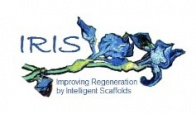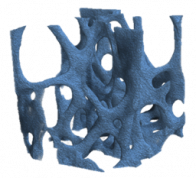Biomaterials
Specific Mission
The research of the Biomaterial group aims to design, engineer and develop, from lab scale to pre-industrial level new biocompatible, bioactive and bioresorbable materials as well as new fabrication technologies including additive manufacturing and 3D printing (in collaboration with the Additive manufacturing group).
We design, develop and produce bioactive and bioresorbable 3D structures (scaffolds), also as fibers for different application fields such as: bone and cartilage regeneration, skin repair and nerve regeneration. Research lines on nanostructured multifunctional materials to vehicle drugs, biomolecules and therapeutic ions as well as surface modification to impart antibacterials/antifouling properties are active.
Main research topics
- 3D printing of biomaterials and growth factors (in collaboration with the Additive Manufacturing group)
- Biomimetic scaffolds containing bioactive glasses, ceramics and collagen (Bioactive and/or bioresorbable)
- Mesoporous materials for controlled release of drugs, growth factors and therapeutic ions (osteogenic, antibacterial and pro-osteogenic effect)
- Nano-hydroxyapatite for bone-like composite (in collaboration with the Ceramic group)
- Biodegradable nanocapsules for the release of growth factors under acidic environment
- Injectable bone cements for bone regeneration
- Ceramic composites for structural, prosthetic, dental and spinal applications (in collaboration with the Ceramic group)
- Bioresorbable glass fibers for scaffold fabrication and drug release (in collaboration with GLANCE-Prof. Daniel Milanese)
- Biomaterial functionalisation for enhanced antibacterial and antifouling properties.
- Mesoporous coatings to increase the performance of micromechanics biosensors (in collaboration with MPMNT, Prof. Carlo Ricciardi)
- Computed nanotomography and its use in the material field
Main Partnerships
- Prof. Davide Janner, Politecnico di Torino (DISAT)
- Prof. Roberto Pisano e Prof. Antonello Barresi, Politecnico di Torino (DISAT)
- Prof. Gianluca Ciardelli e Prof.ssa Valeria Chiono Politecnico di Torino (DIMEAS)
- Prof. Alberto Arezzo (Unito- Molinette)
- Prof. Antonio Maria Fea (UNITO)
- Prof. Giovanni Vozzi, Prof. De Maria Carmelo, Facoltà di Ingegneria, Università of Pisa
- Dott. Antonio Manca, IRCC Candiolo
- Prof. Alessandro Masse’ Dott. A. Aprato, Traumatologia, Ortopedia e Medicina del Lavoro CTO Torino
- Prof. Leonardo Ricotti, Scuola Superiore Sant'Anna (Pisa)
- Prof. Kenneth Dalgarno, University of Newcastle (UK)
- Prof. Maria Vallet Regí, Dott. Miguel Manzano, Universidad Complutense de Madrid (Spain)
- Prof. Georg Duda, Dr. Evi Lippnes, Dr. Katharina Schmidt-Bleek, Charité-Universitatsmediz in Berlin (Germany)
- Prof. Aldo Boccaccini, Erlangen University (Germany)
- Prof.. Lino Ferreira, Faculty of Medicine, University of Coimbra (Portugal)
- Prof. Adelino Leite Moreira, Faculdade de Medicina da Universidade do Porto (Portugal)Prof.ssa Livia Visai, Dipartimento di Medicina Molecolare, Università di Pavia
- Prof.ssa Monica Mattioli-Belmonte, Dipartimento di Scienze Cliniche e Molecolari Università Politecnica delle Marche
- Prof.ssa Milena Fini, Prof. Nicola Baldini (Istituto Ortopedico Rizzoli- Bologna)
- Dr. Francesco Chiavaioli, CNR Sesto Fiorentino
- Dr. Gianluca Cidonio, IIT Roma
- Prof. Nicola Pugno, Università degli Studi di Trento
- Prof. Luigi De Nardo, Politecnico di Milano
- Prof. Alessandra Giuliani, Università Politecnica delle Marche
- Prof. Gerardo Catapano, Università della Calabria:bioreattori
- Prof. Maria Pau Ginebra, Universitat Politecnica de Catalunya-Spain
- Prof. Jérôme Chevalier, INSA (Institut National des Sciences Appliquées) de Lyon (France)
- Prof. Rainer Gadow, IFKB (Institut für Fertigungstechnologie keramischer Bauteile), Universität Stuttgart (Germany)
- Prof. Marc Anglada, Universitat Politècnica de Catalunya, Barcelona (Spain)
- Nobil Bio Ricerche (Italy),
- Cellogic GmbH (Germany),
- InTrauma (Italy)
- NOVAICOS (Italy)
- CORCYM (Italy)
- Bioinicia SL (Spain)
- Santorini Scientific (UK)
Projects and publications
-
 Selected recent publications
2023
Selected recent publications
2023-
Extrusion 3D printing of a multiphase collagen-based material: An optimized strategy to obtain biomimetic scaffolds with high shape fidelity
Article
Montalbano, Giorgia; Calore, Roberto; VITALE BROVARONE, Chiara
JOURNAL OF APPLIED POLYMER SCIENCE
WILEY
Vol.140 pp.14 ISSN:0021-8995 DOI:10.1002/app.53593 -
Optimization of an Injectable, Resorbable, Bioactive Cement Able to Release the Anti-Osteoclastogenic Biomolecule ICOS-Fc for the Treatment of Osteoporotic Vertebral Compression Fractures
Article
Banche-Niclot, Federica; Corvaglia, Ilaria; Cavalera, Caterina; Boggio, Elena; Gigliotti, Casimiro Luca; Dianzani, Umberto; Tzagiollari, Antzela; Dunne, Nicholas; Manca, Antonio; Fiorilli, Sonia; Vitale-Brovarone, Chiara
BIOMOLECULES
MDPI
Vol.13 pp.28 ISSN:2218-273X DOI:10.3390/biom13010094
-
PEG-coated Mesoporous Silicas to release large biomolecule in Acidic Environment and their use in 3D printed collagen scaffolds
Proceeding
BANCHE NICLOT, Federica; Montalbano, Giorgia; Fiorilli, SONIA LUCIA; VITALE BROVARONE, Chiara
In: Titolo volume non avvalorato
Società Italiana Biomateriali
Congresso Nazionale Biomateriali (SIB2021) (Lecce (ITA)) 11-14 July 2021
-
Strontium-releasing mesoporous bioactive glasses with anti-adhesive zwitterionic surface as advanced biomaterials for bone tissue regeneration
Article
Pontremoli, Carlotta; Izquierdo-Barba, Isabel; Montalbano, Giorgia; Vallet-Regí, María; VITALE BROVARONE, Chiara; Fiorilli, SONIA LUCIA
JOURNAL OF COLLOID AND INTERFACE SCIENCE
elsevier
pp.12 ISSN:0021-9797 DOI:10.1016/j.jcis.2019.12.047
-
Surface area enhancement by mesoporous silica deposition on microcantilever sensors for small molecule detection
Article
Stassi, Stefano; Cauda, Valentina Alice; Fiorilli, SONIA LUCIA; Ricciardi, Carlo
JOURNAL OF MATERIALS CHEMISTRY. C
Royal Society of Chemistry
Vol.3 pp.7 (pp.12507-12513) ISSN:2050-7526 DOI:10.1039/C5TC02635K
-
Extrusion 3D printing of a multiphase collagen-based material: An optimized strategy to obtain biomimetic scaffolds with high shape fidelity





 Web site
Web site